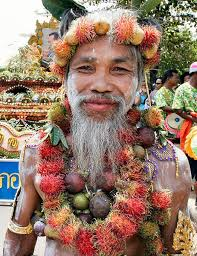To All,

The plant world outdid itself when it invented the rambutan, which looks like a cross between a sea creature, a cactus, and a disease-producing microbe. Alternatively, it looks like something the cat coughed up. I bet the first time a rambutan was eaten by a human was because somebody lost a bet. The rambutan takes the prize so far for the most expensive fruit per pound at $9.99/pound at Whole Foods. (On Amazon two pounds of rambutan cost $27.95.) I sorted through the rambutan heaped up in the Whole Foods exotic fruits aisle and picked out four likely looking specimens, though I had no idea what to look for. (Later I learned that the ideal is bright red with green tips on the little hairs, though this doesn't matter that much.) Each rambutan is about the size of a golf ball, and mine cost about 78 cents each. While my rambutan came from Guatemala, this fruit originated in Southeast Asia. "Rambutan" in Malaysian means hair. Its Vietnamese name means messy hair. While exotic to us, the rambutan is like the apple of Southeast Asia.
While it's a puzzle how to approach a monstrosity like this, it turns out that this fantastic fruit is surprisingly easy to eat. For a good video that lasts less than two minutes, see https://www.youtube.com/watch?v=kj84UpZg0cg. You just cut around its equator with a knife, and the outer, hairy part peels off with no difficulty. (If you have no knife and are in a hurry, you can bite it open. The little hairs are not hazardous.) There is a large, white, moist, egg-shaped fruit under the peel; there is a biggish seed in the center, but it is easy to deal with. One option is to eat the fruit like a tiny ear of corn. Another option is to bite or tear the fruit to open it up and then peel the fruit away from the seed. There are other ways, but the message is that you can't go wrong with this forgiving fruit. Below you see pictures of my four rambutan in various phases of being prepared. (Tyrannosaurus rex for scale.)
After cutting them up, the little hairs were all over the place. Avoid rambutan if you are allergic to little hairs.
The fruits have the same color, texture, size, shape and overall feel as the lychee nut. In fact, they are in the same family, and once the peel is removed the resemblance is striking. As for taste, the rambutan goes down very easily with a very pleasing flavor, somewhat milder than that of lychee nuts.
The verdict: This fruit not only has an inviting flavor but is fun to look at, play with, and prepare. The killer drawback, however, is the price. While comparable to lychee nuts in terms of the pleasure provided, each rambutan costs about six times as much as a lychee nut. It is hard to justify such extravagance.
The seeds can be cooked and eaten. I did not try this since I only had four seeds.
For such a showy fruit, the flower is surprisingly subdued. The first picture below shows a flower cluster with a pollinator. The second picture gives a better sense of a rambutan tree in full bloom.
There are more than 200 rambutan cultivars. Common goals of cultivars with most plants are properties like shelf life, shippability, and flavor, but with rambutan one of the main goals is to keep the height of the trees under fifteen feet to facilitate the harvest. This approach has produced the rambutan hedge. Imagine your yard surrounded by a rambutan hedge. Your neighbors, stuck with their fuddy-duddy privet, would be green. (Before you succumb to this fantasy, however, read the next paragraph.)
It might occur to you to plant rambutan in your yard since its yield of eight tons per acre, at $9.99/pound would greatly augment your retirement income. This plan will, however, require you to move to Central or South America since rambutan only flourishes within 12 to 15 degrees of the equator. Even Florida is too frosty for this plant, which can't take temperatures below 48 degrees F.
This showy fruit has caught the fancy of Internet experts, and there is an extraordinary variety of rambutan videos. You can use the link above to locate them. I find the ones in languages that I cannot understand especially riveting. An example is https://www.youtube.com/watch?v=SNdaoTWZozA, which is perhaps in Hindi. https://www.youtube.com/watch?v=CU0zbVvdVt4 eschews education and concentrates solely on giving the artist's view of rambutan.
The pictures below show rambutan, a favorite of animals, being eaten by orangutan, parrot, tapir(?), and woodpecker.
Rambutan is a happy fruit, as shown in the pictures below. If you eat rambutan, you, too, will be happy.
You will recall from the report on lychee nuts that it is considered proper to peel and eat a lychee nut while in the grocery store. This same rule applies to the rambutan. In the picture below you see a dignified woman sampling a rambutan. (How many of the fruits in the background can you identify? The Fruit Explorer's work is never done.)
Your party tip takes advantage of the fact that animals love to eat rambutan. Take your guests to a petting zoo and give them a supply of rambutan. The animals will crowd around, and your guests will come to understand the deep commonality between animals and man and will experience the unity of all life. For years afterward your guests will remember your party and how it made them feel at one with nature.
Rambutan plays well with other fruit, as demonstrated by the pictures below.
Rambutan is used in various food and drink preparations, including one available at Trader Joe's.
Artists have made use of rambutan in many different ways, as the pictures below attest.
The latest addition to my bucket list is to get a rambutan hat.































































